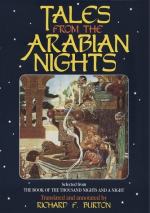[FN#26] Ibn al-Wardi mentions an “Isle of Apes” in the Sea of China and Al-Idrisi places it two days’ sail from Sukutra (Dwipa Sukhatra, Socotra). It is a popular error to explain the Homeric and Herodotean legend of the Pygmies by anthropoid apes. The Pygmy fable (Pygmaei Spithamai=1 cubit=3 spans) was, as usual, based upon fact, as the explorations of late years have proved: the dwarfs are homunculi of various tribes, the Akka, Doko, Tiki-Tiki, Wambilikimo ("two-cubit men"), the stunted race that share the central regions of Intertropical Africa with the abnormally tall peoples who speak dialects of the Great South African tongue, miscalled the “Bantu.” Hole makes the Pygmies “monkeys,” a word we have borrowed from the Italians (monichio a mono=ape) and quotes Ptolemy, (Ape-Islands) East of Sunda.
[FN#27] A kind of barge (Arab. Barijah, plur. Bawarij) used on the Nile of sub-pyriform shape when seen in bird’s eye. Lane translates “ears like two mortars” from the Calc. Edit.
[FN#28] This giant is distinctly Polyphemus; but the East had giants and cyclopes of her own (Hierozoicon ii. 845). The Ajaib al-Hind (chapt. cxxii.) makes Polyphemus copulate with the sheep. Sir John Mandeville (if such person ever existed) mentions men fifty feet high in the Indian Islands; and Al-Kazwini and Al-Idrisi transfer them to the Sea of China, a Botany Bay for monsters in general.
[FN#29] Fire is forbidden as a punishment amongst Mosems, the idea being that it should be reserved for the next world. Hence the sailors fear the roasting more than the eating: with ours it would probably be the reverse. The Persian insult “Pidar-sokhtah"=(son of a) burnt father, is well known. I have noted the advisability of burning the Moslem’s corpse under certain circumstances: otherwise the murderer may come to be canonised.
[FN#30] Arab. “Mastabah"=the bench or form of masonry before noticed. In olden Europe benches were much more used than chairs, these being articles of luxury. So King Horne “sett him abenche;” and hence our “King’s Bench” (Court).
[FN#31] This is from the Bresl. Edit. vol. iv. 32: the Calc. Edit gives only an abstract and in the Bul. Edit. the Ogre returned “accompanied by a female, greater than he and more hideous.” We cannot accept Mistress Polyphemus.
[FN#32] This is from Al-Kazwini, who makes the serpent “wind itself round a tree or a rock, and thus break to pieces the bones of the breast in its belly.”
[FN#33] “Like a closet,” in the Calc. Edit. The serpent is an exaggeration of the python which grows to an enormous size. Monstrous Ophidia are mentioned in sober history, e.g. that which delayed the army of Regulus. Dr. de Lacerda, a sober and sensible Brazilian traveller, mentions his servants sitting down upon a tree-trunk in the Captaincy of San Paulo (Brasil), which began to move and proved to be a huge snake. F. M. Pinto (the Sindbad of




